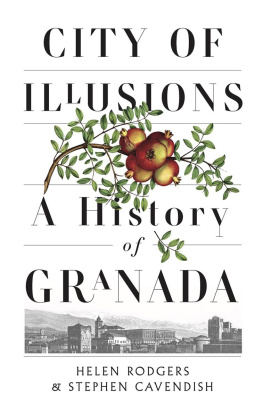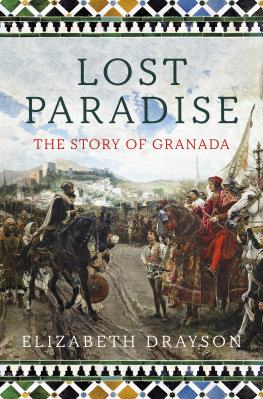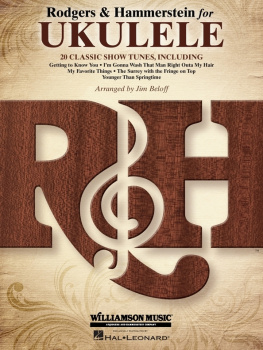Helen Rodgers and Stephen Cavendish - City of Illusions: A History of Granada
Here you can read online Helen Rodgers and Stephen Cavendish - City of Illusions: A History of Granada full text of the book (entire story) in english for free. Download pdf and epub, get meaning, cover and reviews about this ebook. year: 2021, publisher: Hurst, genre: Religion. Description of the work, (preface) as well as reviews are available. Best literature library LitArk.com created for fans of good reading and offers a wide selection of genres:
Romance novel
Science fiction
Adventure
Detective
Science
History
Home and family
Prose
Art
Politics
Computer
Non-fiction
Religion
Business
Children
Humor
Choose a favorite category and find really read worthwhile books. Enjoy immersion in the world of imagination, feel the emotions of the characters or learn something new for yourself, make an fascinating discovery.
- Book:City of Illusions: A History of Granada
- Author:
- Publisher:Hurst
- Genre:
- Year:2021
- Rating:5 / 5
- Favourites:Add to favourites
- Your mark:
- 100
- 1
- 2
- 3
- 4
- 5
City of Illusions: A History of Granada: summary, description and annotation
We offer to read an annotation, description, summary or preface (depends on what the author of the book "City of Illusions: A History of Granada" wrote himself). If you haven't found the necessary information about the book — write in the comments, we will try to find it.
City of Illusions: A History of Granada — read online for free the complete book (whole text) full work
Below is the text of the book, divided by pages. System saving the place of the last page read, allows you to conveniently read the book "City of Illusions: A History of Granada" online for free, without having to search again every time where you left off. Put a bookmark, and you can go to the page where you finished reading at any time.
Font size:
Interval:
Bookmark:

HELEN RODGERS
STEPHEN CAVENDISH
A History of Granada

HURST & COMPANY, LONDON
First published in the United Kingdom in 2021 by
C. Hurst & Co. (Publishers) Ltd.,
83 Torbay Road, London, NW6 7DT
Helen Rodgers and Stephen Cavendish, 2021
All rights reserved.
Printed in the United Kingdom.
The right of Helen Rodgers and Stephen Cavendish to be identified as the authors of this publication is asserted by them in accordance with the Copyright, Designs and Patents Act, 1988.
A Cataloguing-in-Publication data record for this book is available from the British Library.
ISBN: 9781787385580
This book is printed using paper from registered sustainable and managed sources.
www.hurstpublishers.com
Quien no ha visto Granada, no ha visto nada.
He who has not seen Granada, has not seen a thing.
Local saying
***
Dale limosna, mujer,
que no hay en la vida nada
como la pena de ser
ciego en Granada.
Give him alms, woman,
because in life there is nothing
like the sorrow of being
blind in Granada.
Francisco de Icaza, Mexican poet
(authors translation)
We should like to express our thanks to the staff at both the Escuela de Estudios rabes and the Casa de los Tiros newspaper archive for allowing us access to their invaluable collections, and also to all those who work at Granadas wonderful historical sites for providing so much detail during the course of our research, much of which is overlooked in the written sources. Most of all, our gratitude and great admiration go to our neighbours, whose passion for Granadas unique story and determination to maintain its most beautiful traditions have been a true inspiration in bringing this book to life.
A book such as thiswritten for English-speaking readers, but whose subject matter covers people and places whose names originate in both Arabic and Spanish and have often been changed throughout historypresents a number of challenges in terms of deciding what names to use to make the characters and locations most familiar and accessible for the reader.
In Britain until recent times, the names of Spanish rulers tended to be anglicised in history textbooks; thus the Catholic MonarchsIsabel and Fernandohave generally been known as Isabella and Ferdinand. Whilst these two names could easily be used in their Spanish form without much confusion, others are more problematic. The Holy Roman Emperor Charles V is known in Spanish history as El Rey Carlos I and also Carlos V, which was a foreign title he acquired three years after becoming Spains king. Felipe II, as a consort of Mary Tudor, is far better known to English speakers as Philip II, who later dispatched his Armada against Elizabeth I. For ease of reading, therefore, Spanish monarchs are referred to throughout by their anglicised names.
This also allows for consistency when it comes to Arabic. The names in Western sources for the later Nasrids stemmed from the difficulty the Castilians had with Arabic pronunciation. Boabdilthe last emir of Granadagrew from a mishearing of Abu Abdullah, whilst his fathers name in Spanish, Muley Hacn, is a corruption of Maulaya (meaning Lord) Abu-l Hasan. This was not simply ignorance; Arab chroniclers also used their own names for Spanish monarchs, the real ones being equally incomprehensible to their ears. In this book, then, the more famous English renderings of the names of historical Arab figures are used where they exist.
History is nothing if not a journey of change, however, and in recent times there has been a trend in the English-speaking world to using Spanish spellings. It is not uncommon now to see Andaluca in English texts, instead of the anglicised Andalusia, or Crdoba, instead of its traditional spelling in English without the accent. This presents questions over place names that differ more between the two languages, such as Seville and Castile versus Sevilla and Castilla. For consistency, places with Spanish or Arabic names have again been given their anglicised forms where these exist. There are also, of course, nations and borders today that were not around in mediaeval times, so Morocco as it is understood now does not work as well as the Arabic Maghreb, which is used on occasion in this book.
Within Granada itself, places are generally referred to by their Spanish names, even if they date from the Arab period. This is simply to assist the reader in locating these around the city, for whilst sites frequented by tourists may have an official English translation, many do not. The choice is one faced by any author of histories of the non-English-speaking world, and the decision will be different in each individual case. The resolution here was reached by what the authors hope will lead to the ease and enjoyment of the reader.
In 1754, an amateur archaeologist named Juan de Flores began digging beneath the streets of Granadas Moorish Albaicn district for signs of the citys early history. Local people were enthralled as, day by day, his excavations unearthed artefacts that pointed to a pre-Islamic, Roman city on the site, including statues, vases, coins, jewellery, and bases of columnsone of which appeared to be from a temple dedicated to Apollo, later consecrated as a church. Granada was jubilant; with Floress artefacts, it would be able to wash away the shame of its heathen past under the Moors and hold its head high within Catholic Spain as a fundamentally Christian city that pre-dated the arrival of the Muslims. Alas for the local Christians. In 1763 the excavations ended, and a decade later Floress finds were denounced as elaborate forgeries. For years he and a group of artisans had been fabricating piece after piece of archaeological evidence and burying these in the tunnels beneath the Albaicn, before bringing them to light in front of admiring crowds the next day.
Curiously enough, this was not the first time that local people had attempted to falsify Granadas history for reasons of political expediency. Some 150 years earlier, in the late sixteenth century, the last of the citys Morisco inhabitantsthose who had been forcibly converted to Christianity after the Reconquistahad forged and secretly buried a collection of mysterious lead tablets, bound into books and written in a supposedly ancient form of Arabic. These purported that the first Arab to arrive on the Iberian Peninsula had been a first-century saint, St Caecilius, who had been converted to Christianity by Christ himself. This in turn suggested that, rather than being viewed as Muslim invaders, the Moorsthe collective term used to describe the Muslims of the Iberian peninsulashould instead be recognised as an integral part of Spains early Christianity. And, the logic went, if an Arab had originally come to Spain as a Christian, then the looming expulsion of the Moriscos from the Iberian Peninsulaon the suspicion that they remained Muslim at heartwas groundless. A Christian cult emerged in Granada based around these lead books, as well as charred bones believed to be those of the martyred St Caecilius, which culminated in the consecration of the Abbey of the Sacromonte.
Despite the elaborate hoax, the plot to save the Moriscos from exile failed: the year 1609 saw between 200,000 and 300,000 of them forcibly driven out of Spain. Yet for the Old Christians of the citythose who had moved to Granada following the fall of the Muslim emirate in 1492the cult of the lead books of the Sacromonte lived on. It declined only years later, when, in 1682, the Vatican declared these to be forgeries, leaving the deeply Christian locals frustrated at the lack of proof for a Christian foundation to their city. It was this frustration that was temporarily eased by the theatre of Floress archaeological digs, only to be dashed once more when his fraud was publicly revealed more than fifteen years later. In the 1770s, Flores was tried and found guilty of falsifying his discoveries. He was sentenced, and his fakes destroyed. The passageways under the Albaicn were sealed, new buildings were erected in the area, and the story of the excavations faded into history. Granada, meanwhile, was about to enter a new era, when first Napoleons army and later the Romantic artists and writers of the nineteenth century would come to the citynot fascinated by any potential early Christian heritage so yearned for by the citys inhabitants, but instead intoxicated by thoughts of finding and recreating what they imagined was the lost exoticism of Granada of the Moors.
Font size:
Interval:
Bookmark:
Similar books «City of Illusions: A History of Granada»
Look at similar books to City of Illusions: A History of Granada. We have selected literature similar in name and meaning in the hope of providing readers with more options to find new, interesting, not yet read works.
Discussion, reviews of the book City of Illusions: A History of Granada and just readers' own opinions. Leave your comments, write what you think about the work, its meaning or the main characters. Specify what exactly you liked and what you didn't like, and why you think so.











